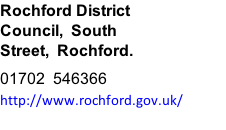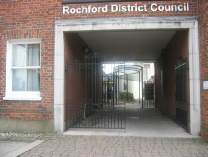








Free Exhibition Opportunity at the Rayleigh Windmill
20 December 2018
Rochford District Council are offering local artists/voluntary community groups the opportunity to promote their work with free Exhibition space at the famous Rayleigh Windmill.
The award winning and historical landmark hosts a small museum as well as a self contained exhibition space on the 2nd floor.
The Windmill will be open on Wednesdays 10am-
There is no charge for artist / community exhibitions. Artists / groups would be allocated approximately 4-
The deadline for expressing an interest in this opportunity is 10am on Friday 1 February 2019.
Cllr Mike Webb, Portfolio Holder for the Community says “The Windmill is a fantastic venue and in a great location. By making this free space available to them to endorse their art, we hope that this will be a great opportunity to get their name and work out there for the public to see.”
For more information on how to apply and to express an interest please contact the Council’s Leisure team at leisure@rochford.gov.uk or call 01702 318 120. You can also visit Rayleigh Windmill’s Facebook page at: www.facebook.com/rayleighwindmill or Twitter page @Rayleigh_Mill
New video shows aerial footage of Wallasea Island Wild Coast Project!
1 November 2018
Breath-
This nature reserve forms the UK’s largest coastal wetland restoration – twice the size of the City of London – and viewers can now head to https://www.rochford.gov.uk/wetlands to see it in its full glory.
This habitat is designed to encourage the return of species that historically bred in the UK, such as spoonbills and Kentish plover, as well as new breeding species like black-
Rochford District Council’s Portfolio Holder for Enterprise, Cllr George Ioannou, said: “It is only when you view the RSPB’s aerial footage of Wallasea Island that you truly comprehend the magnitude of this project, which forms the largest conservation and engineering scheme of its type in Europe. The images show how a new sea wall has been created, along with landscaped islands and lagoons, with the help of three million tonnes of material excavated from beneath London. I look forward to seeing the scores of birds, including Avocets, short-
UK’s largest coastal wetland restoration nears completion.
September 2018
The Wallasea Island Wild Coast project’s restoration of 670 hectares of coastal wetland on the Essex coast will be soon be complete, nearly 10 years after work started.
The creation this year of 269 hectares of new lagoons and marshes on the southern part of the island forms the final piece of the puzzle.
At an event on Friday attended by project partners, funders and stakeholders, local MP Mark Francois put the finishing touches to a new island to mark the final stage of restoration.
Friday 21 September – Nearly 10 years after work to restore 670 hectares of coastal wetland on the Essex coast, the Wallasea Island Wild Coast project – the largest coastal wetland restoration project ever undertaken in the UK – is nearing completion.
Wallasea Island nature reserve is a wetland for the future: designed to offset losses of wildlife rich coastal habitats such as saltmarsh to sea level rises; and to provide habitat to encourage the return of species that historically bred in the UK, such as spoonbills and Kentish plover, as well as new breeding species like black-
At an event MP for Rayleigh and Wickford and long-
Mark Francois MP: “I am delighted to have been invited to help mark the final stage of this fantastic project to restore Essex’s wild coast, having had the opportunity to see the creation of the Wallasea Island Wild Coast unfold over the last decade.
“Managing our landscapes well for nature in the face of wildlife loss and the effects of climate change is a massive challenge. The scale and scope of the Wild Coast project’s ambition in transforming Wallasea Island, not only creating wetland habitats rich in wildlife, but helping adapt the coast to future sea level rises, shows what is possible when people work together to meet this challenge head on.
“I hope the Wild Coast project will inspire other equally ambitious and innovative solutions to address the impacts of climate change in ways that benefit nature. The legacy of the project is sure to live on in Essex in the form of the wildlife that is already starting to make use of the newly created habitats, and the people who are starting to visit the island in larger and larger numbers to enjoy it and access this invaluable addition to Essex’s natural coastal heritage.”
Work to restore the remaining 269 Hectares to the south of the island began Earlier this summer, funded by Viridor Credits and Enovert Community Trust. The creation of three new areas of coastal wetland habitat – 55 hectares of brackish marsh, 82 hectares of freshwater marsh, and 132 hectares of tidal saline lagoon is now in its final stages. Added to the 399 hectares already restored at Wallasea Island since 2011, the new habitats will complete the UK’s largest coastal wetland restoration, and the largest mosaic of habitats of its kind in Northern Europe.
Work to transform Wallasea Island’s reclaimed arable landscape started nearly 10 years ago with the partnership between Crossrail and the RSPB. 3 million tonnes of material excavated from beneath London in Europe’s largest civil engineering project was transported to the Essex Coast, where it was used to build a new sea wall and create painstakingly landscapes islands and lagoons in what would become Jubilee Marsh. Just 3 years after the tide was allowed back onto this part of the island for the first time in 400 years, wildlife has already started to return: avocets and ringed plovers, wintering brent geese, and birds of prey including merlins and short-
South Essex Councils set out vision for region’s growth
June 2018
Councils across South Essex have agreed a common approach to supporting the development of housing and key infrastructure over the next twenty years.
The Association of South Essex Local Authorities (ASELA) – which is made up of Basildon, Brentwood, Castle Point, Essex County, Rochford, Southend-
This, along with preparing a Joint Strategic Plan for South Essex would assist future plans for development to ensure new transport links, health and social infrastructure, business and skill opportunities are all included and will ensure that the 90,000 homes that have been identified as being need across south Essex over the next twenty years are built.
Background:
The Government is looking to local authorities to prepare Statements of Common Ground as part of a new Local Plan process, and more specifically, to provide the main evidence to demonstrate that strategic planning matters have been dealt with effectively and the legal provisions of the ‘Duty to Cooperate’ have been met. ASELA have been a national pilot for the new process and are the first collective of local authorities to reach this stage of the new process.
Between the six local authority areas, 4,500 homes need to be built each year over the next 20 years (90,000) to meet Government housing targets.
The Statement of Commons Ground is going through the respective councils democratic process and can be viewed on https://www.castlepoint.gov.uk/agendas-
The Association of South Essex Local Authorities (ASELA) consists of Basildon, Brentwood, Castle Point, Essex County, Rochford, Southend-
All seven councils have recognised the need to work across borders on strategic issues such as infrastructure, planning and growth, skills, housing and transport connectivity. An MoU was signed on 10 January 2018.
The Statement of Common Ground looks at the next steps – including how the joint strategic plan will be put together. After this, the South Essex Spatial Strategy will be published; this will identify areas for growth, infrastructure and housing. It will go out to public engagement in 2019 and is designed to help deliver future growth and local plans.